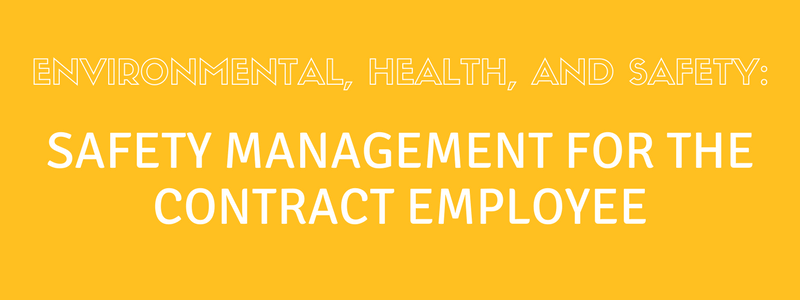Safety Management – For the Contract Employee

How To Account For Contract Employees In Your Safety Management System
‘Temporary work’ or ‘temporary employment’ refers to an employment situation whereby the working arrangement for a worker is limited to a certain pre-determined period based on the specific needs of the employer for a specific task or tasks. There is a myriad of terms that are also used to denote temporary work: ‘contractual,’ ‘seasonal,’ ‘interim,’ ‘casual,’ “outsourced.” Even ‘freelance’ workers are technically temporary workers. Some temporary, more highly skilled professionals (particularly those engaged in white-collar work, such as law, finance, and accounting) also refer to themselves as ‘consultants.’ If those consultants are in your workplace for a period, then they too should be considered temporary workers.
Temporary workers are an everyday reality in the modern American workplace. According to an estimate by the American Staffing Association, as reported in a Fairfield County Business Journal article in 2006, there are an estimated 2.5 million people per day employed by staffing companies in the U.S. That represents nearly 2 percent of the entire workforce. Temporary employment has grown exponentially since the 1980s and early 1990s due to persistent business trends regarding downsizing and restructuring. However, the tendency by many companies continues to be that of treating temporary workers as the ‘other,’ as if somehow apart from the fully employed workforce. When it comes to safety management, this is a huge mistake. For one thing, although only in the workplace temporarily, these workers are still a logistical and practical necessity in an organization. Not involving them fully in the company’s safety management system is akin to pretending that these workers are not physically present. And that’s plain dumb. For another, any temporary worker is a just as much viable hazard in the workplace as a permanent employee. In fact, they could even pose a greater hazard if they are not properly informed of a company’s safety procedures, HIRA, and incident reporting system, for starters.
Employers and Contract Employee Safety
OSHA is adamant about the significant role of employers and the safety of temporary workers. OSHA states that it, “recommends that the temporary staffing agency and the host employer set out their respective responsibilities for compliance with applicable OSHA standards in their contract.” OSHA goes further – it states unequivocally that both a staffing/labor agency and the host employer are jointly responsible for maintaining a safe work environment for a given temporary worker. This mandate includes safety-related training, hazard and risk communication, and recordkeeping requirements, as just a few examples. OSHA also observes that the agency has “concerns that some employers may use temporary workers as a way to avoid meeting all their compliance obligations under the OSH Act and other worker protection laws…”
In a scathing 2015 report, also picked up by Fortune Magazine, OSHA expressed its grave concern with what it saw as an increased risk of injuries in the workplace due to “important changes in the structure of the employment relationships in U.S. workplaces…” OSHA viewed two principal culprits in this trend, namely what it views as the purposeful misclassification of wage employees as ‘independent contractors’, as well as the widespread use of temporary workers. Fortune offered a simple reason as to why safety declines in the face of these hiring trends: “A company that relies on temporary employees has little financial incentive to ensure workers’ well-being.” As harsh of a business reality this may be, such cynicism does nothing to excuse the actions of such employers. Nor is it remotely ethical. Not to mention the legal implications thereof. Temporary workers are not the workplace equivalent of passing ships in the night. Their safety, health, and wellbeing are as much an obligation of an employer as that for any employee. As always, workplace safety is not a privilege but an ethical and legal right – and one which makes business sense anyway.
ConvergePoint
Our comprehensive safety management software solutions can help you to track every step of attaining or assessing competency. Operating on one secure SharePoint portal using templates built on industry best practices, the actions of your team can be managed through role-based access permissions. A detailed version history page provides a real-time record of version changes that supports every element of policy workflow from creation to ongoing management and revision.
The opportunity to move your manual systems to the next level is closer than you may think. To learn more about our software now available on,SharePoint Online via Office 365, schedule a demo now.
